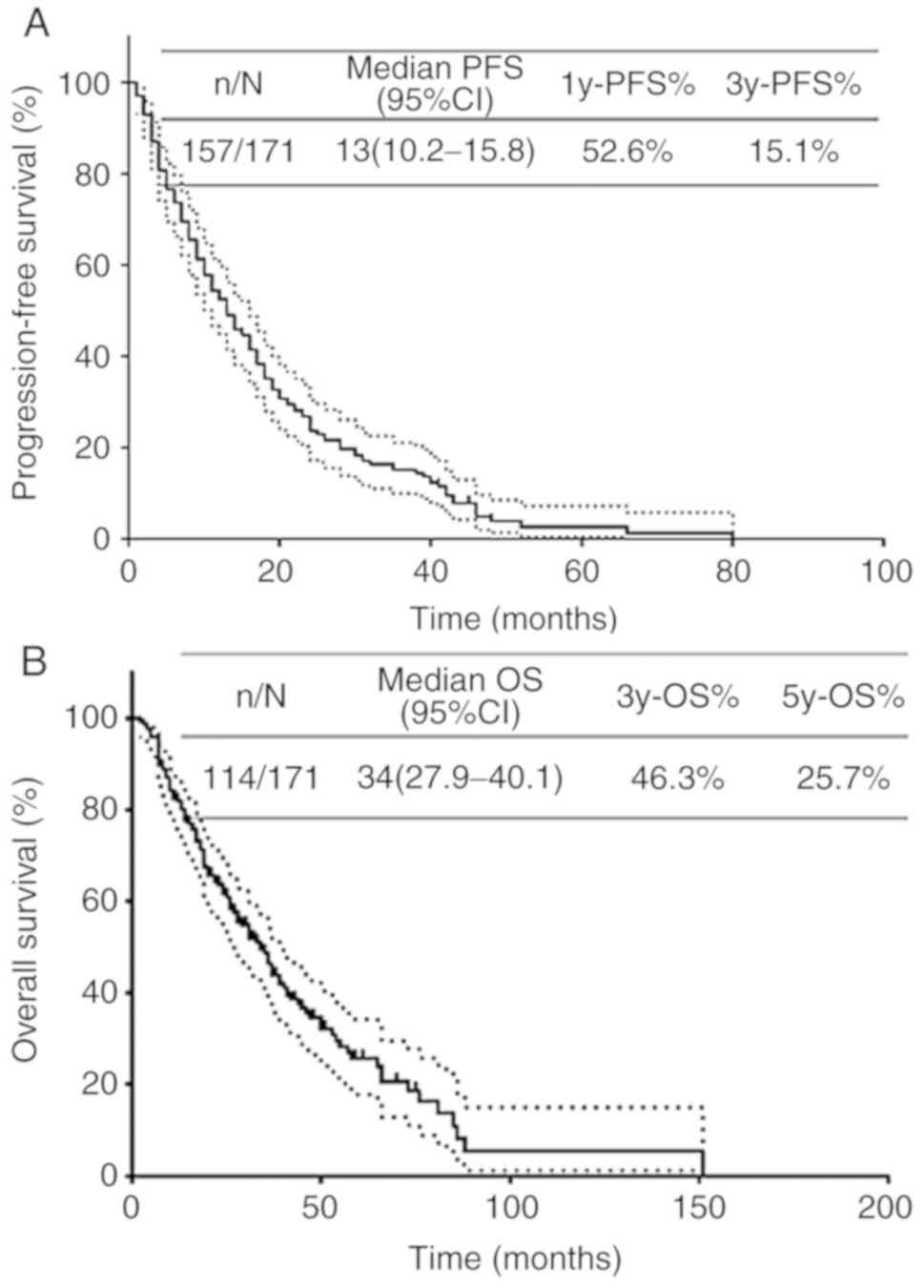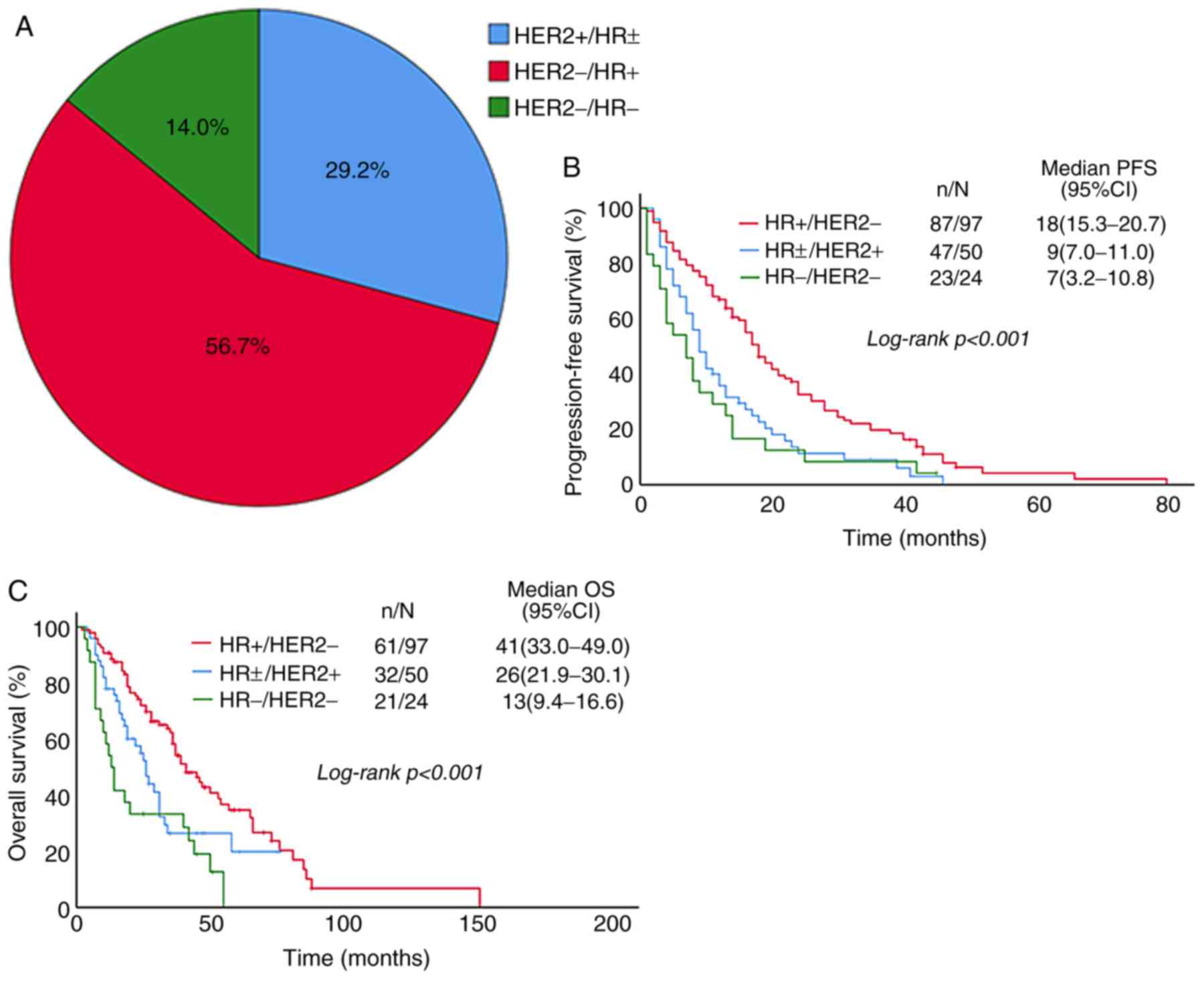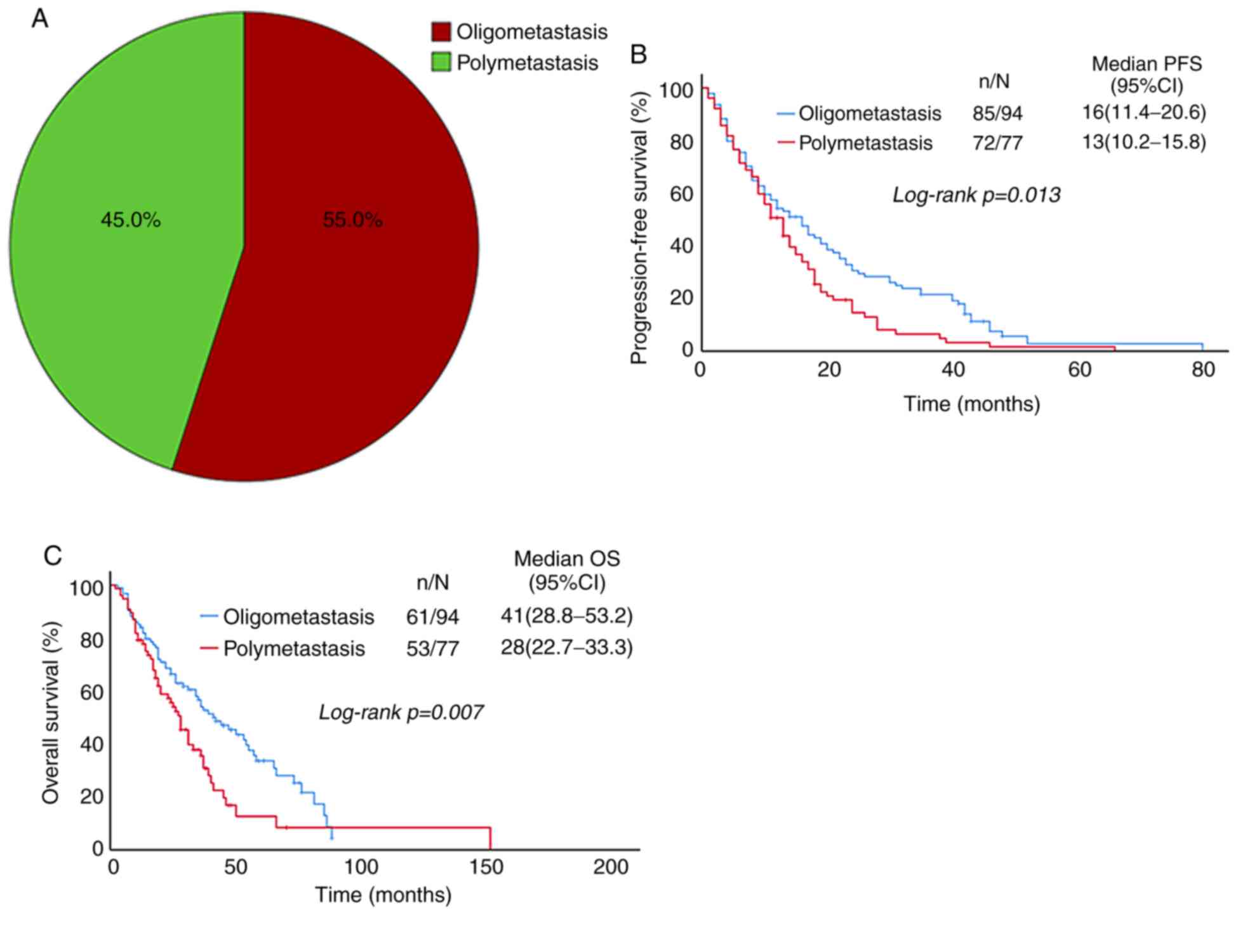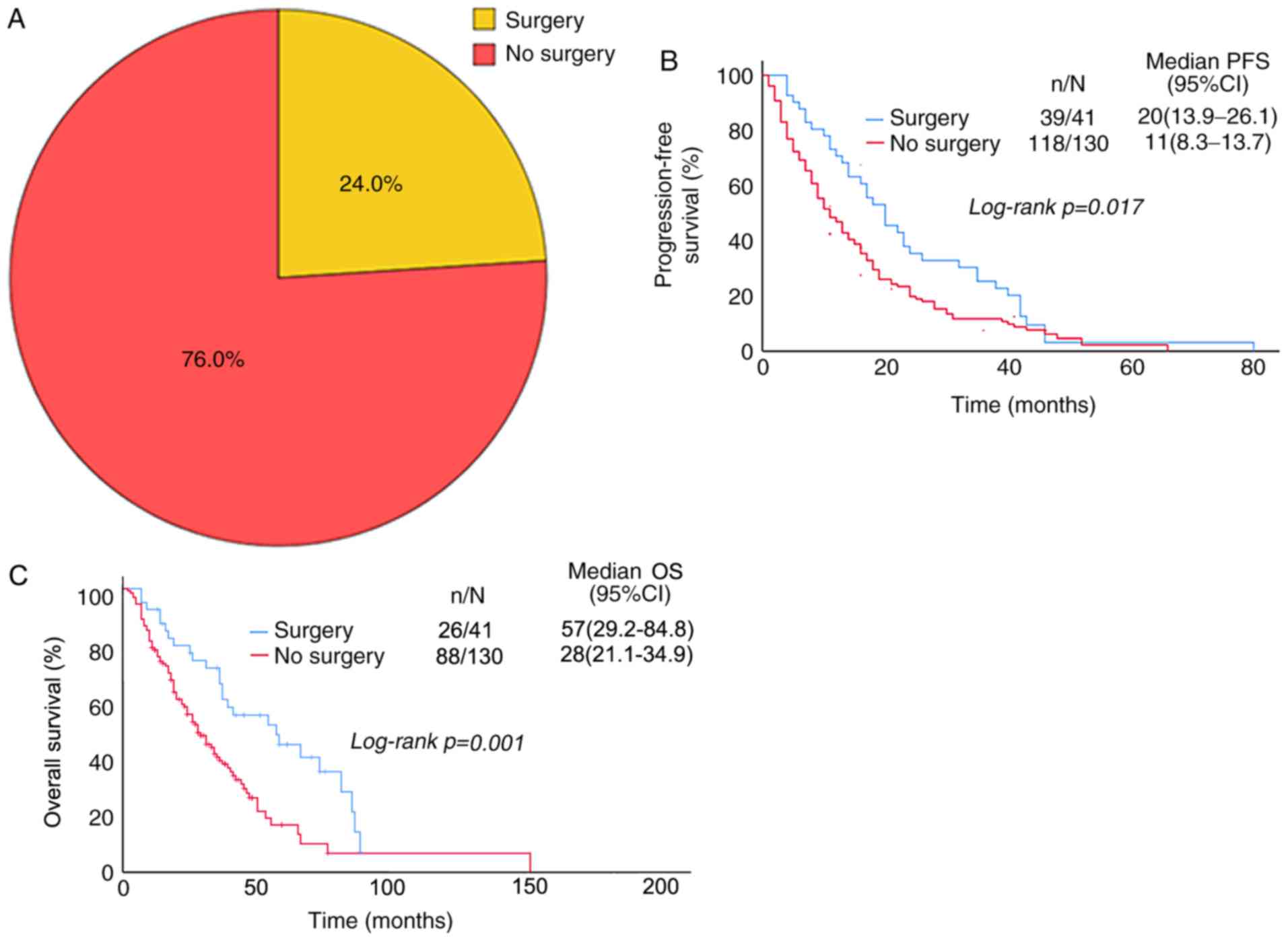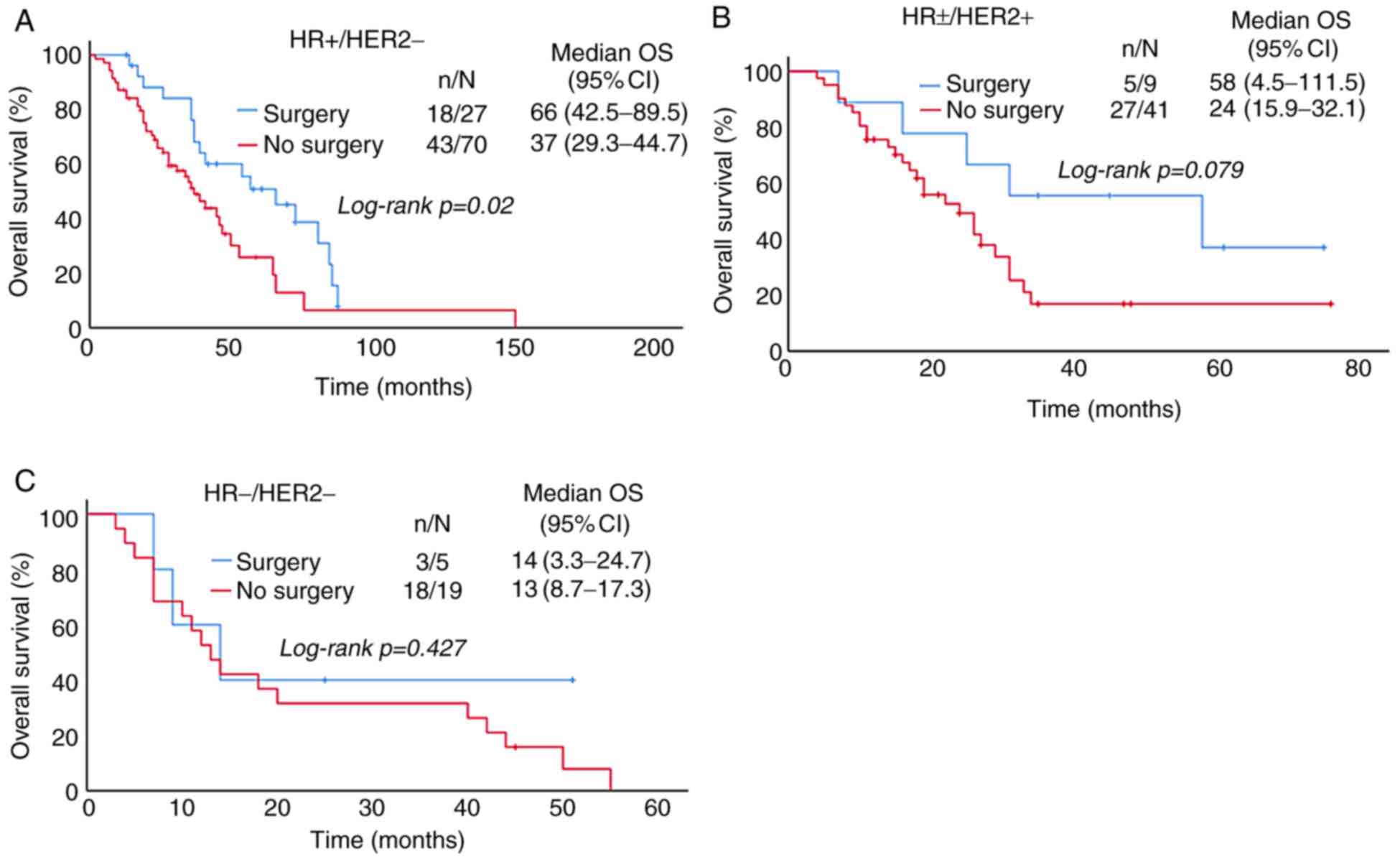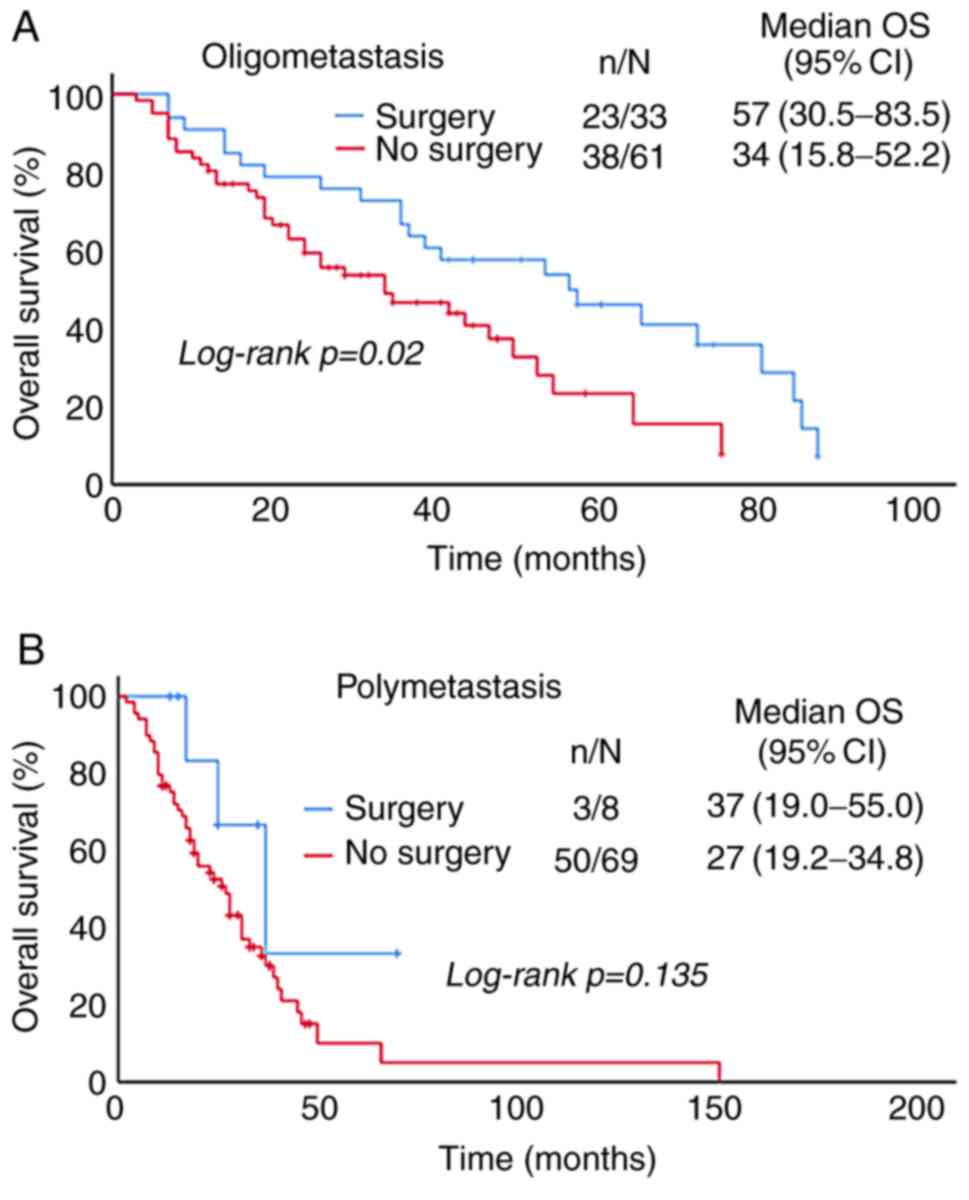|
1
|
Bray F, Ferlay J, Soerjomataram I, Siegel
RL, Torre LA and Jemal A: Global cancer statistics 2018: GLOBOCAN
estimates of incidence and mortality worldwide for 36 cancers in
185 countries. CA Cancer J Clin. 68:394–424. 2018. View Article : Google Scholar : PubMed/NCBI
|
|
2
|
Badwe R, Hawaldar R, Nair N, Kaushik R,
Parmar V, Siddique S, Budrukkar A, Mittra I and Gupta S:
Locoregional treatment versus no treatment of the primary tumour in
metastatic breast cancer: An open-label randomised controlled
trial. Lancet Oncol. 16:1380–1388. 2015. View Article : Google Scholar : PubMed/NCBI
|
|
3
|
Cardoso F, Spence D, Mertz S,
Corneliussen-James D, Sabelko K, Gralow J, Cardoso MJ, Peccatori F,
Paonessa D, Benares A, et al: Global analysis of
advanced/metastatic breast cancer: Decade report (2005–2015).
Breast. 39:131–138. 2018. View Article : Google Scholar : PubMed/NCBI
|
|
4
|
Dawood S, Broglio K, Gonzalez-Angulo AM,
Buzdar AU, Hortobagyi GN and Giordano SH: Trends in survival over
the past two decades among white and black patients with newly
diagnosed stage IV breast cancer. J Clin Oncol. 26:4891–4898. 2008.
View Article : Google Scholar : PubMed/NCBI
|
|
5
|
Malmgren JA, Mayer M, Atwood MK and Kaplan
HG: Differential presentation and survival of de novo and recurrent
metastatic breast cancer over time: 1990–2010. Breast Cancer Res
Treat. 167:579–590. 2018. View Article : Google Scholar : PubMed/NCBI
|
|
6
|
Cortesi L, Toss A, Cirilli C, Marcheselli
L, Braghiroli B, Sebastiani F and Federico M: Twenty-years
experience with de novo metastatic breast cancer. Int J Cancer.
137:1417–1426. 2015. View Article : Google Scholar : PubMed/NCBI
|
|
7
|
Andre F, Slimane K, Bachelot T, Dunant A,
Namer M, Barrelier A, Kabbaj O, Spano JP, Marsiglia H, Rouzier R,
et al: Breast cancer with synchronous metastases: Trends in
survival during a 14-year period. J Clin Oncol. 22:3302–3308. 2004.
View Article : Google Scholar : PubMed/NCBI
|
|
8
|
Cortesi L, Cirilli C, Rashid I, Artioli E
and Federico M: Changes in survival from metastatic breast cancer
during the last twenty-years: A population based study in Northern
Italy. J Clin Oncol. 27:11252009.
|
|
9
|
Lobbezoo DJ, van Kampen RJ, Voogd AC,
Dercksen MW, van den Berkmortel F, Smilde TJ, van de Wouw AJ,
Peters FP, van Riel JM, Peters NA, et al: Prognosis of metastatic
breast cancer subtypes: The hormone receptor/HER2-positive subtype
is associated with the most favorable outcome. Breast Cancer Res
Treat. 141:507–514. 2013. View Article : Google Scholar : PubMed/NCBI
|
|
10
|
Hammond ME, Hayes DF, Dowsett M, Allred
DC, Hagerty KL, Badve S, Fitzgibbons PL, Francis G, Goldstein NS,
Hayes M, et al: American society of clinical oncology/college of
American pathologists guideline recommendations for
immunohistochemical testing of estrogen and progesterone receptors
in breast cancer (unabridged version). Arch Pathol Lab Med.
134:e48–e72. 2010.PubMed/NCBI
|
|
11
|
Liu F, Lang R, Wei J, Fan Y, Cui L, Gu F,
Guo X, Pringle GA, Zhang X and Fu L: Increased expression of
SDF-1/CXCR4 is associated with lymph node metastasis of invasive
micropapillary carcinoma of the breast. Histopathology. 54:741–750.
2009. View Article : Google Scholar : PubMed/NCBI
|
|
12
|
Cui LF, Guo XJ, Wei J, Liu FF, Fan Y, Lang
RG, Gu F, Zhang XM and Fu L: Overexpression of TNF-alpha and TNFRII
in invasive micropapillary carcinoma of the breast:
Clinicopathological correlations. Histopathology. 53:381–388. 2008.
View Article : Google Scholar : PubMed/NCBI
|
|
13
|
Qian XL, Wen HY, Yang YL, Gu F, Guo XJ,
Liu FF, Zhang L, Zhang XM and Fu L: Assessment of dual-probe Her-2
fluorescent in situ hybridization in breast cancer by the 2013
ASCO/CAP guidelines produces more equivocal results than that by
the 2007 ASCO/CAP guidelines. Breast Cancer Res Treat. 159:31–39.
2016. View Article : Google Scholar : PubMed/NCBI
|
|
14
|
Chen L, Romond E, Chokshi S, Saeed H,
Hodskins J, Stevens M, Pasley G, Weiss H and Massarweh S: A
prognostic model of early breast cancer relapse after standard
adjuvant therapy and comparison with metastatic disease on initial
presentation. Breast Cancer Res Treat. 136:565–572. 2012.
View Article : Google Scholar : PubMed/NCBI
|
|
15
|
Dawood S, Broglio K, Ensor J, Hortobagyi
GN and Giordano SH: Survival differences among women with de novo
stage IV and relapsed breast cancer. Ann Oncol. 21:2169–2174. 2010.
View Article : Google Scholar : PubMed/NCBI
|
|
16
|
Vaz-Luis I, Lin NU, Keating NL, Barry WT,
Lii H, Winer EP and Freedman RA: Racial differences in outcomes for
patients with metastatic breast cancer by disease subtype. Breast
Cancer Res Treat. 151:697–707. 2015. View Article : Google Scholar : PubMed/NCBI
|
|
17
|
Lee ES, Jung SY, Kim JY, Kim JJ, Yoo TK,
Kim YG, Lee KS, Lee ES, Kim EK, Min JW, et al: Identifying the
potential long-term survivors among breast cancer patients with
distant metastasis. Ann Oncol. 27:828–833. 2016. View Article : Google Scholar : PubMed/NCBI
|
|
18
|
den Brok WD, Speers CH, Gondara L, Baxter
E, Tyldesley SK and Lohrisch CA: Survival with metastatic breast
cancer based on initial presentation, de novo versus relapsed.
Breast Cancer Res Treat. 161:549–556. 2017. View Article : Google Scholar : PubMed/NCBI
|
|
19
|
Soran A, Ozmen V, Ozbas S, Karanlik H,
Muslumanoglu M, Igci A, Canturk Z, Utkan Z, Ozaslan C, Evrensel T,
et al: A randomized controlled trial evaluating resection of the
primary breast tumor in women presenting with de novo stage IV
breast cancer: Turkish Study (Protocol MF07-01). J Clin Oncol.
34:10052016. View Article : Google Scholar
|
|
20
|
Thomas A, Khan SA, Chrischilles EA and
Schroeder MC: Initial surgery and survival in stage IV breast
cancer in the United States, 1988–2011. JAMA Surg. 151:424–431.
2016. View Article : Google Scholar : PubMed/NCBI
|
|
21
|
Lambertini M, Ferreira AR, Di Meglio A,
Poggio F, Puglisi F, Sottotetti F, Montemurro F, Poletto E,
Bernardo A, Risi E, et al: Patterns of care and clinical outcomes
of HER2-positive metastatic breast cancer patients with newly
diagnosed stage IV or recurrent disease undergoing first-line
trastuzumab-based therapy: A multicenter retrospective cohort
study. Clin Breast Cancer. 17:601–610.e2. 2017. View Article : Google Scholar : PubMed/NCBI
|
|
22
|
Badwe R, Parmar V, Hawaldar R, Nair N,
Kaushik R, Siddique S, Navale A, Budrukkar A, Mittra I and Gupta S:
Surgical removal of primary tumor and axillary lymph nodes in women
with metastatic breast cancer at first presentation: A randomized
controlled trial. Cancer Res. 73 (24 Suppl):S2–02. 2013.
|
|
23
|
King TA, Lyman J, Gonen M, Voci A, De Brot
M, Boafo C, Sing AP, Hwang ES, Alvarado MD, Liu MC, et al: A
prospective analysis of surgery and survival in stage IV breast
cancer: TBCRC 013. J Clin Oncol. 34:2359–2365. 2016. View Article : Google Scholar : PubMed/NCBI
|
|
24
|
Molnár IA, Molnár BÁ, Vízkeleti L, Fekete
K, Tamás J, Deák P, Szundi C, Székely B, Moldvay J, Vári-Kakas S,
et al: Breast carcinoma subtypes show different patterns of
metastatic behavior. Virchows Arch. 470:275–283. 2017. View Article : Google Scholar : PubMed/NCBI
|
|
25
|
Lobbezoo DJ, van Kampen RJ, Voogd AC,
Dercksen MW, van den Berkmortel F, Smilde TJ, van de Wouw AJ,
Peters FP, van Riel JM, Peters NA, et al: Prognosis of metastatic
breast cancer: Are there differences between patients with de novo
and recurrent metastatic breast cancer. Br J Cancer. 112:1445–1451.
2015. View Article : Google Scholar : PubMed/NCBI
|
|
26
|
Savci-Heijink CD, Halfwerk H, Hooijer GK,
Horlings HM, Wesseling J and van de Vijver MJ: Retrospective
analysis of metastatic behaviour of breast cancer subtypes. Breast
Cancer Res Treat. 150:547–557. 2015. View Article : Google Scholar : PubMed/NCBI
|
|
27
|
Tao L, Chu L, Wang LI, Moy L, Brammer M,
Song C, Green M, Kurian AW, Gomez SL and Clarke CA: Occurrence and
outcome of de novo metastatic breast cancer by subtype in a large,
diverse population. Cancer Causes Control. 27:1127–1138. 2016.
View Article : Google Scholar : PubMed/NCBI
|
|
28
|
Vaz-Luis I, Lin NU, Keating NL, Barry WT,
Winer EP and Freedman RA: Factors associated with early mortality
among patients with de novo metastatic breast cancer: A
population-based study. Oncologist. 22:386–393. 2017. View Article : Google Scholar : PubMed/NCBI
|
|
29
|
Wang H, Zhang C, Zhang J, Kong L, Zhu H
and Yu J: The prognosis analysis of different metastasis pattern in
patients with different breast cancer subtypes: A SEER based study.
Oncotarget. 8:26368–26379. 2017.PubMed/NCBI
|
|
30
|
Wu SG, Li H, Tang LY, Sun JY, Zhang WW, Li
FY, Chen YX and He ZY: The effect of distant metastases sites on
survival in de novo stage-IV breast cancer: A SEER database
analysis. Tumour Biol. 39:10104283177050822017. View Article : Google Scholar : PubMed/NCBI
|
|
31
|
Hellman S and Weichselbaum RR:
Oligometastases. J Clin Oncol. 13:8–10. 1995. View Article : Google Scholar : PubMed/NCBI
|
|
32
|
Weichselbaum RR and Hellman S:
Oligometastases revisited. Nat Rev Clin Oncol. 8:378–382. 2011.
View Article : Google Scholar : PubMed/NCBI
|
|
33
|
Milano MT, Katz AW, Schell MC, Philip A
and Okunieff P: Descriptive analysis of oligometastatic lesions
treated with curative-intent stereotactic body radiotherapy. Int J
Radiat Oncol Biol Phys. 72:1516–1522. 2008. View Article : Google Scholar : PubMed/NCBI
|
|
34
|
Kobayashi T, Ichiba T, Sakuyama T, Arakawa
Y, Nagasaki E, Aiba K, Nogi H, Kawase K, Takeyama H, Toriumi Y, et
al: Possible clinical cure of metastatic breast cancer: Lessons
from our 30-year experience with oligometastatic breast cancer
patients and literature review. Breast Cancer. 19:218–237. 2012.
View Article : Google Scholar : PubMed/NCBI
|
|
35
|
Wong AC, Watson SP, Pitroda SP, Son CH,
Das LC, Stack ME, Uppal A, Oshima G, Khodarev NN, Salama JK, et al:
Clinical and molecular markers of long-term survival after
oligometastasis-directed stereotactic body radiotherapy (SBRT).
Cancer. 122:2242–2250. 2016. View Article : Google Scholar : PubMed/NCBI
|















